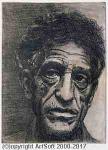Alberto Giacometti
Alberto Giacometti
stil: Expressionism; Surrealism; Post-Impressionism; Naive Art / Primitivism;
yer: Borgonovo
Doğmuş: 1901
Ölüm: 1966
Biyografi:
Alberto Giacometti was a Swiss sculptor, painter, draftsman and printmaker. Beginning in 1922, he lived and worked mainly in Paris but regularly visited his hometown Borgonovo to see his family and work on his art.
Giacometti was one of the most important sculptors of the 20th century. His work was particularly influenced by artistic styles such as Cubism and Surrealism. Philosophical questions about the human condition, as well as existential and phenomenological debates played a significant role in his work. Around 1935 he gave up on his Surrealistic influences in order to pursue a more deepened analysis of figurative compositions. Giacometti wrote texts for periodicals and exhibition catalogues and recorded his thoughts and memories in notebooks and diaries. His self-critical nature led to great doubts about his work and his ability to do justice to his own artistic ideas but acted as a great motivating force.
Between 1938 and 1944 Giacometti's sculptures had a maximum height of seven centimeters (2.75 inches). Their small size reflected the actual distance between the artist's position and his model. In this context he self-critically stated: "But wanting to create from memory what I had seen, to my terror the sculptures became smaller and smaller". After the war, Giacometti created his most famous sculptures: his extremely tall and slender figurines. These sculptures were subject to his individual viewing experience—between an imaginary yet real, a tangible yet inaccessible space.
In Giacometti's whole body of work, his painting constitutes only a small part. After 1957, however, his figurative paintings were equally as present as his sculptures. His almost monochromatic paintings of his late work do not refer to any other artistic styles of modernity.
Giacometti was born in Borgonovo, Switzerland, in the canton Graubünden's southerly alpine valley Val Bregaglia near the Italian border, as the eldest of four children of Giovanni Giacometti, a well-known post-Impressionist painter, and Annetta Giacometti-Stampa. He was a descendant of Protestant refugees escaping the inquisition. Coming from an artistic background, he was interested in art from an early age. Alberto attended the Geneva School of Fine Arts. His brothers Diego (1902–1985) and Bruno (1907–2012) would go on to become artists and architects as well. Additionally, Zaccaria Giacometti, later professor of constitutional law and chancellor of the University of Zurich, grew up together with them, having been orphaned at the age of 12 in 1905.
In 1922, he moved to Paris to study under the sculptor Antoine Bourdelle, an associate of Rodin. It was there that Giacometti experimented with Cubism and Surrealism and came to be regarded as one of the leading Surrealist sculptors. Among his associates were Miró, Max Ernst, Picasso, Bror Hjorth, and Balthus.
Between 1936 and 1940, Giacometti concentrated his sculpting on the human head, focusing on the sitter's gaze. He preferred models he was close to—his sister and the artist Isabel Rawsthorne (then known as Isabel Delmer). This was followed by a phase in which his statues of Isabel became stretched out; her limbs elongated. Obsessed with creating his sculptures exactly as he envisioned through his unique view of reality, he often carved until they were as thin as nails and reduced to the size of a pack of cigarettes, much to his consternation. A friend of his once said that if Giacometti decided to sculpt you, "he would make your head look like the blade of a knife".
During WWII Giacometti took refuge in Switzerland. There in 1946 he met Annette Arm, a secretary for the Red Cross; they married in 1949.
After his marriage his tiny sculptures became larger, but the larger they grew, the thinner they became. For the remainder of Giacometti's life, Annette was his main female model. His paintings underwent a parallel procedure. The figures appear isolated and severely attenuated, as the result of continuous reworking.
Subjects were frequently revisited: one of his favorite models was his younger brother Diego.
In 1958 Giacometti was asked to create a monumental sculpture for the Chase Manhattan Bank building in New York, which was beginning construction. Although he had for many years "harbored an ambition to create work for a public square", he "had never set foot in New York, and knew nothing about life in a rapidly evolving metropolis. Nor had he ever laid eyes on an actual skyscraper", according to his biographer James Lord. Giacometti's work on the project resulted in the four figures of standing women—his largest sculptures—entitled Grande femme debout I through IV (1960). The commission was never completed, however, because Giacometti was unsatisfied by the relationship between the sculpture and the site, and abandoned the project.
In 1962, Giacometti was awarded the grand prize for sculpture at the Venice Biennale, and the award brought with it worldwide fame. Even when he had achieved popularity and his work was in demand, he still reworked models, often destroying them or setting them aside to be returned to years later. The prints produced by Giacometti are often overlooked but the catalogue raisonné, Giacometti – The Complete Graphics and 15 Drawings by Herbert Lust (Tudor 1970), comments on their impact and gives details of the number of copies of each print. Some of his most important images were in editions of only 30 and many were described as rare in 1970.
More...
Wikipedia link: Click Here



![Quatre femmes sur socle [Four Women on a Base] Quatre femmes sur socle [Four Women on a Base]](https://img.wikioo.org/ADC/art.nsf/get_small_image_wikioo?Open&ra=D4BU9U)










